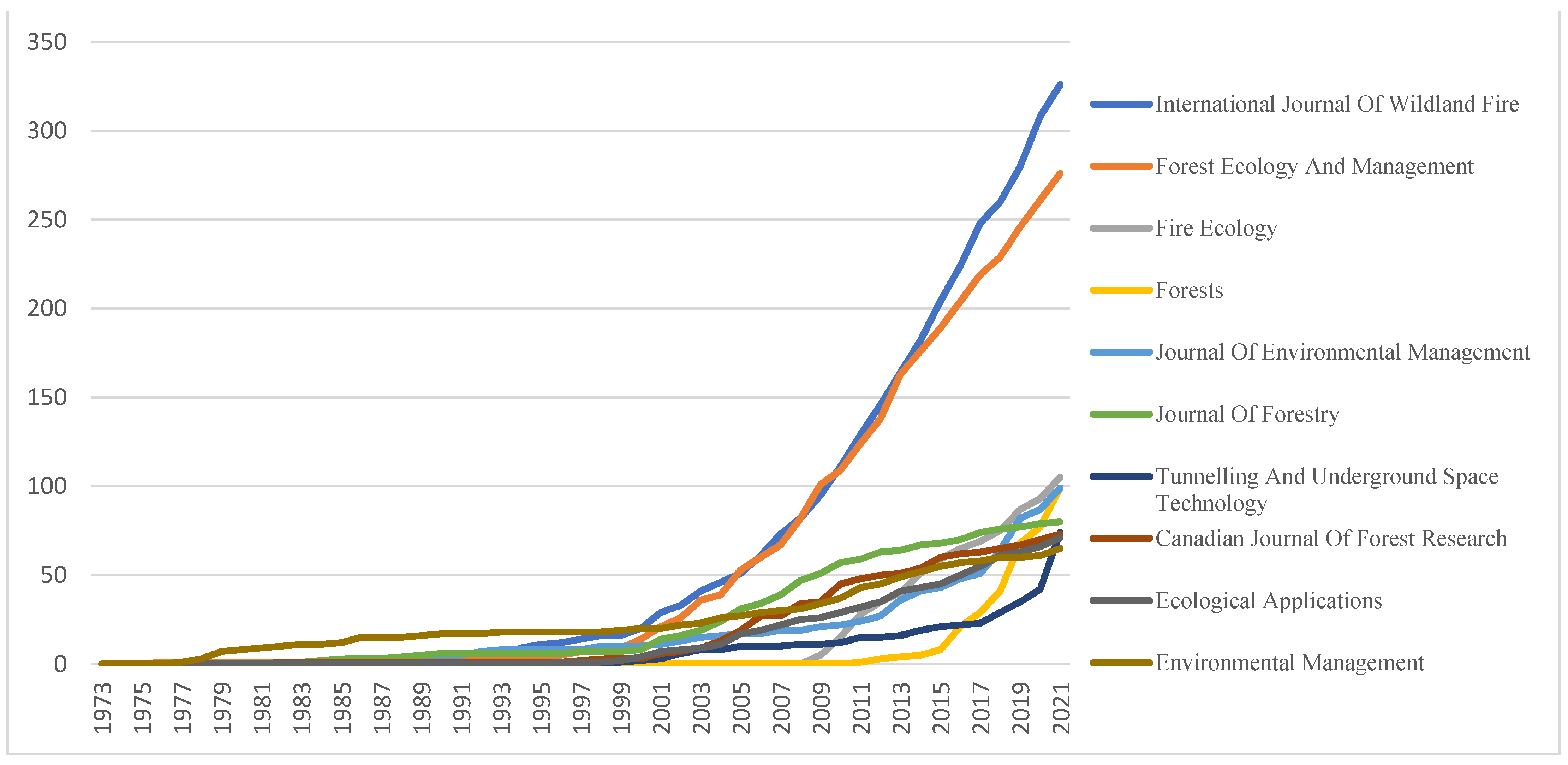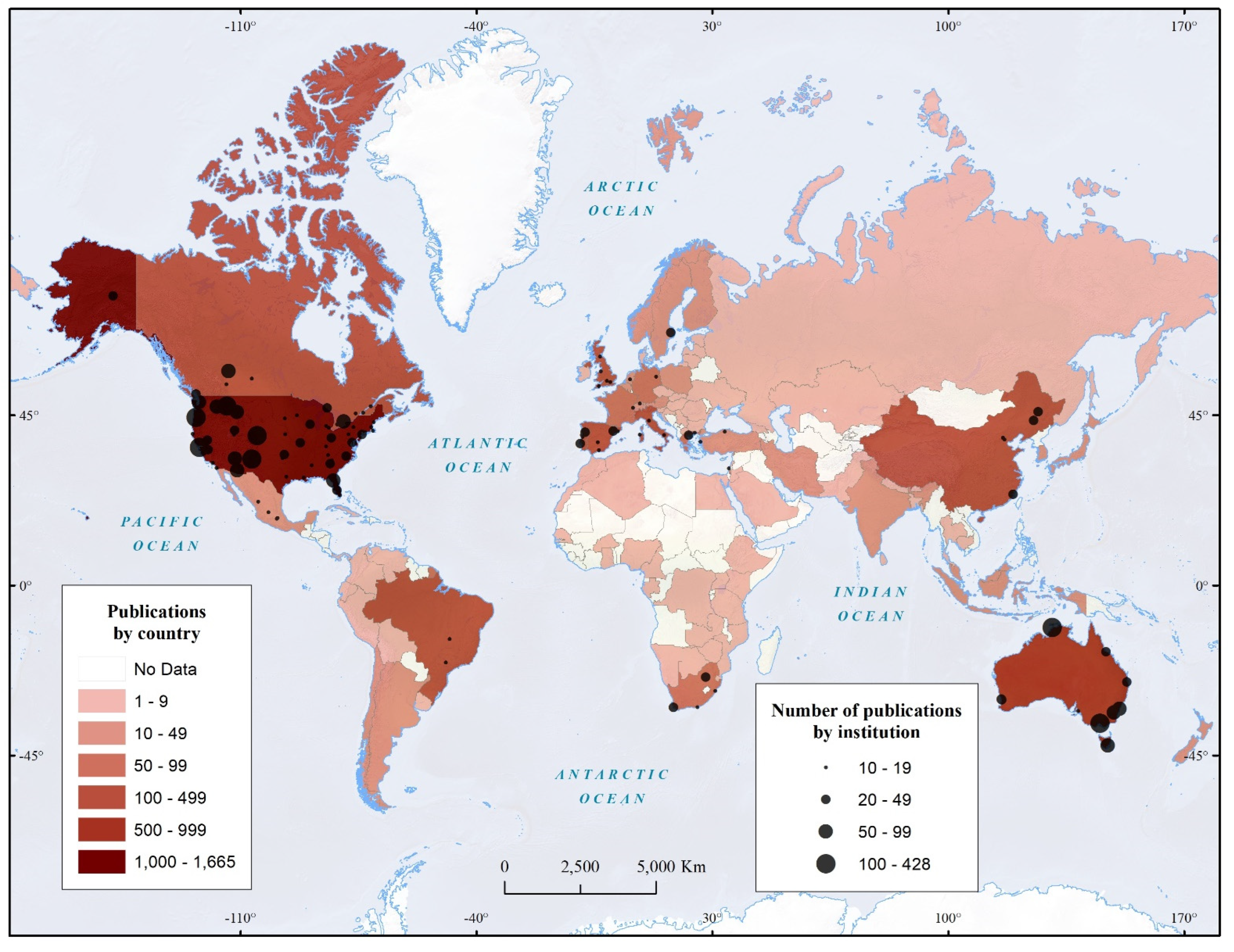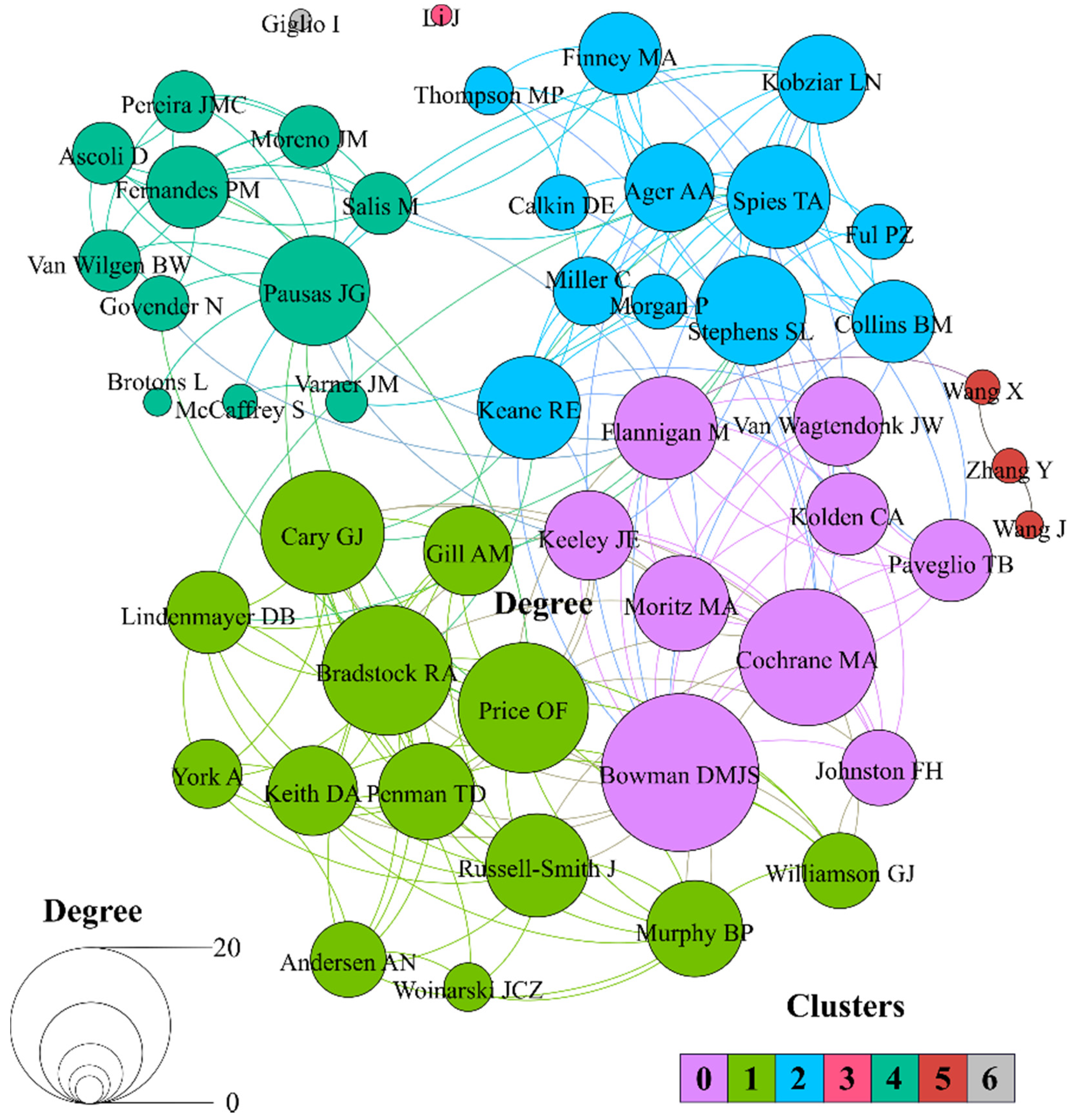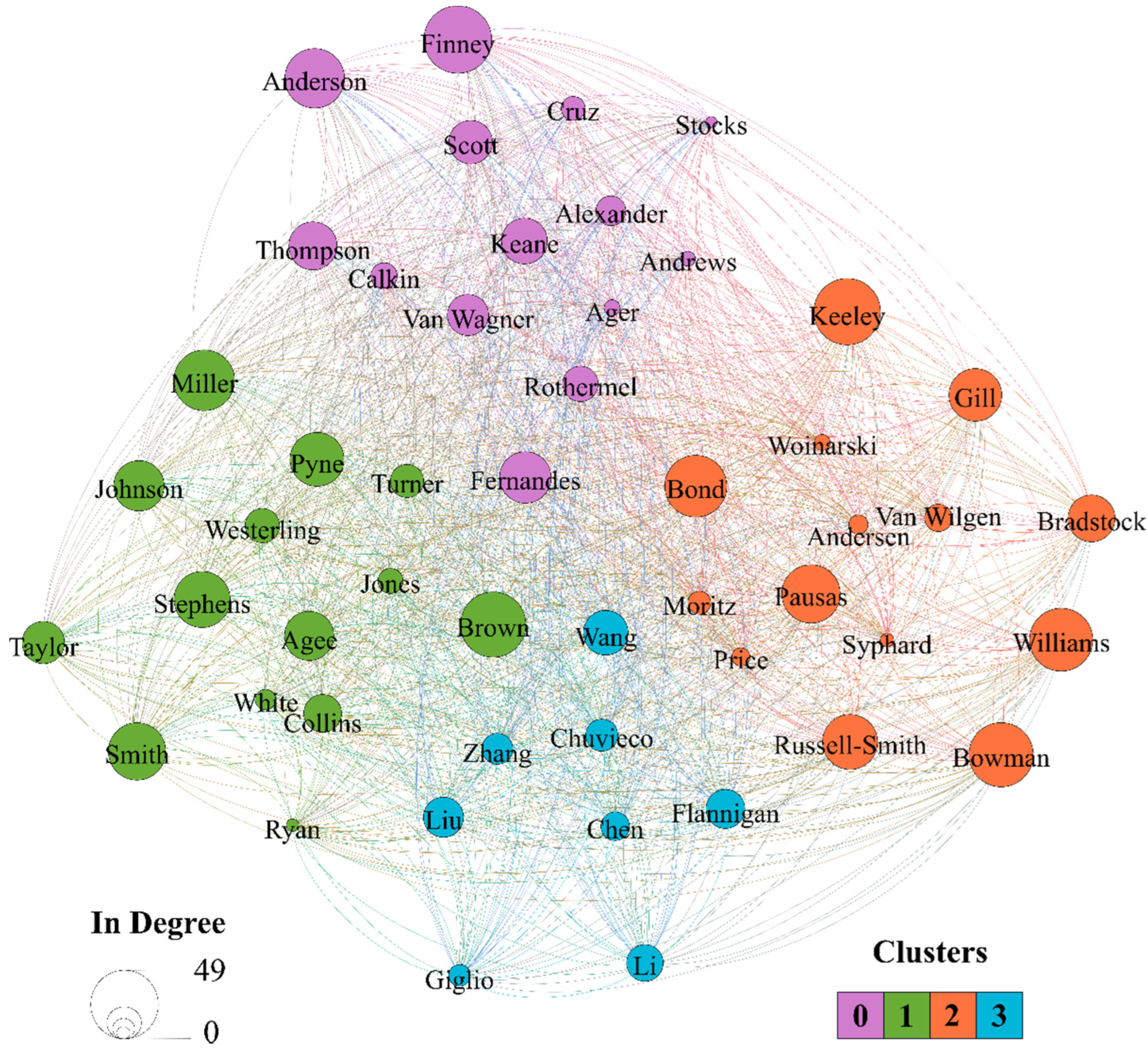A Characterization of Fire-Management Research: A Bibliometric Review of Global Networks and Themes
Abstract
1. Introduction
2. Materials and Methods
3. Results
3.1. Development of Fire-Management Research
3.2. Authorship
3.3. Spatial Characteristics of Fire-Management Research
3.4. Thematic Focus and Methodological Approaches
3.5. Bibliometric Networks
4. Discussion
Supplementary Materials
Author Contributions
Funding
Data Availability Statement
Acknowledgments
Conflicts of Interest
References
- Aponte, C.; de Groot, W.J.; Wotton, B.M.; Aponte, C.; de Groot, W.J.; Wotton, B.M. Forest Fires and Climate Change: Causes, Consequences and Management Options. Int. J. Wildland Fire 2016, 25, i–ii. [Google Scholar] [CrossRef]
- Bowman, D.; Balch, J.; Artaxo, P.; Bond, W.; Carlson, J.; Cochrane, M.; D’Antonio, C.; Defries, R.; Doyle, J.; Harrison, S.; et al. Fire in the Earth System. Science 2009, 324, 481–484. [Google Scholar] [CrossRef] [PubMed]
- Flannigan, M.; Stocks, B.; Turetsky, M.; Wotton, M. Impacts of Climate Change on Fire Activity and Fire Management in the Circumboreal Forest. Glob. Change Biol. 2009, 15, 549–560. [Google Scholar] [CrossRef]
- Smith, A.M.S.; Goldammer, J.G.; Bowman, D.M.J.S. Introducing Fire: A Transdisciplinary Journal to Advance Understanding and Management of Landscape Fires from Local to Global Scales in the Past, Present, and Future. Fire 2018, 1, 2. [Google Scholar] [CrossRef]
- Johnston, F.H.; Borchers-Arriagada, N.; Morgan, G.G.; Jalaludin, B.; Palmer, A.J.; Williamson, G.J.; Bowman, D.M.J.S. Unprecedented Health Costs of Smoke-Related PM2.5 from the 2019–20 Australian Megafires. Nat. Sustain. 2021, 4, 42–47. [Google Scholar] [CrossRef]
- Tedim, F.; Leone, V.; Amraoui, M.; Bouillon, C.; Coughlan, M.R.; Delogu, G.M.; Fernandes, P.M.; Ferreira, C.; McCaffrey, S.; McGee, T.K.; et al. Defining Extreme Wildfire Events: Difficulties, Challenges, and Impacts. Fire 2018, 1, 9. [Google Scholar] [CrossRef]
- Leite, F.; Bento-Gonçalves, A.; Vieira, A.; da Vinha, L. Mega-Fires around the World: A Literature Review. In Wildland Fires–A Worldwide Reality; Nova Science Publishers: New York, NY, USA, 2015; pp. 15–33. [Google Scholar]
- Radeloff, V.C.; Helmers, D.P.; Kramer, H.A.; Mockrin, M.H.; Alexandre, P.M.; Bar-Massada, A.; Butsic, V.; Hawbaker, T.J.; Martinuzzi, S.; Syphard, A.D.; et al. Rapid Growth of the US Wildland-Urban Interface Raises Wildfire Risk. Proc. Natl. Acad. Sci. USA 2018, 115, 3314–3319. [Google Scholar] [CrossRef]
- Withey, K.; Berenguer, E.; Palmeira, A.F.; Espírito-Santo, F.D.B.; Lennox, G.D.; Silva, C.V.J.; Aragão, L.E.O.C.; Ferreira, J.; França, F.; Malhi, Y.; et al. Quantifying Immediate Carbon Emissions from El Niño-Mediated Wildfires in Humid Tropical Forests. Philos. Trans. R. Soc. B Biol. Sci. 2018, 373, 20170312. [Google Scholar] [CrossRef]
- Gillson, L.; Whitlock, C.; Humphrey, G. Resilience and Fire Management in the Anthropocene. Ecol. Soc. 2019, 24, 14. [Google Scholar] [CrossRef]
- Lutz, J.A.; Larson, A.J.; Swanson, M.E. Advancing Fire Science with Large Forest Plots and a Long-Term Multidisciplinary Approach. Fire 2018, 1, 5. [Google Scholar] [CrossRef]
- North, M.P.; Stephens, S.L.; Collins, B.M.; Agee, J.K.; Aplet, G.; Franklin, J.F.; Fulé, P.Z. Reform Forest Fire Management. Science 2015, 349, 1280–1281. [Google Scholar] [CrossRef] [PubMed]
- Sayad, Y.O.; Mousannif, H.; Al Moatassime, H. Predictive Modeling of Wildfires: A New Dataset and Machine Learning Approach. Fire Saf. J. 2019, 104, 130–146. [Google Scholar] [CrossRef]
- Agee, J.K.; Skinner, C.N. Basic Principles of Forest Fuel Reduction Treatments. For. Ecol. Manag. 2005, 211, 83–96. [Google Scholar] [CrossRef]
- Fernandes, P.M.; Davies, G.M.; Ascoli, D.; Fernández, C.; Moreira, F.; Rigolot, E.; Stoof, C.R.; Vega, J.A.; Molina, D. Prescribed Burning in Southern Europe: Developing Fire Management in a Dynamic Landscape. Front. Ecol. Environ. 2013, 11, e4–e14. [Google Scholar] [CrossRef]
- Carmenta, R.; Coudel, E.; Steward, A.M. Forbidden Fire: Does Criminalising Fire Hinder Conservation Efforts in Swidden Landscapes of the Brazilian Amazon? Geogr. J. 2019, 185, 23–37. [Google Scholar] [CrossRef]
- Mistry, J.; Schmidt, I.B.; Eloy, L.; Bilbao, B. New Perspectives in Fire Management in South American Savannas: The Importance of Intercultural Governance. Ambio 2019, 48, 172–179. [Google Scholar] [CrossRef]
- Keane, R.E. Describing Wildland Surface Fuel Loading for Fire Management: A Review of Approaches, Methods and Systems. Int. J. Wildland Fire 2012, 22, 51–62. [Google Scholar] [CrossRef]
- Fernandes, P.M.; Botelho, H.S. A Review of Prescribed Burning Effectiveness in Fire Hazard Reduction. Int. J. Wildland Fire 2003, 12, 117. [Google Scholar] [CrossRef]
- Fillmore, S.D.; McCaffrey, S.M.; Smith, A.M.S. A Mixed Methods Literature Review and Framework for Decision Factors That May Influence the Utilization of Managed Wildfire on Federal Lands, USA. Fire 2021, 4, 62. [Google Scholar] [CrossRef]
- Yang, S.; Yuan, Q.; Dong, J. Are Scientometrics, Informetrics, and Bibliometrics Different? Data Sci. Informetr. 2020, 1, 50. [Google Scholar] [CrossRef]
- Moral-Muñoz, J.A.; Herrera-Viedma, E.; Santisteban-Espejo, A.; Cobo, M.J. Software Tools for Conducting Bibliometric Analysis in Science: An up-to-Date Review. Prof. Inf. 2020, 29, e290103. [Google Scholar] [CrossRef]
- Mishra, M.; Sudarsan, D.; Santos, C.A.G.; Mishra, S.K.; Kar, D.; Baral, K.; Pattnaik, N. An Overview of Research on Natural Resources and Indigenous Communities: A Bibliometric Analysis Based on Scopus Database (1979–2020). Environ. Monit. Assess. 2021, 193, 59. [Google Scholar] [CrossRef] [PubMed]
- Ellegaard, O.; Wallin, J.A. The Bibliometric Analysis of Scholarly Production: How Great Is the Impact? Scientometrics 2015, 105, 1809–1831. [Google Scholar] [CrossRef]
- Flores-Fernández, C.; Aguilera-Eguía, R.; Flores-Fernández, C.; Aguilera-Eguía, R. Indicadores Bibliométricos y Su Importancia En La Investigación Clínica. ¿Por Qué Conocerlos? Rev. Soc. Española Dolor 2019, 26, 315–316. [Google Scholar] [CrossRef]
- Madani, F. ‘Technology Mining’ Bibliometrics Analysis: Applying Network Analysis and Cluster Analysis. Scientometrics 2015, 105, 323–335. [Google Scholar] [CrossRef]
- Liz-Gutiérrez, J.P. La economía de la proximidad en la última década. Criterio Libre 2016, 14, 247–269. [Google Scholar] [CrossRef][Green Version]
- Albort-Morant, G.; Leal-Rodríguez, A.L.; Fernández-Rodríguez, V.; Ariza-Montes, A. Assessing the Origins, Evolution and Prospects of the Literature on Dynamic Capabilities: A Bibliometric Analysis. Eur. Res. Manag. Bus. Econ. 2018, 24, 42–52. [Google Scholar] [CrossRef]
- Xuemei, W.; Mingguo, M.; Xin, L.; Zhiqiang, Z. Applications and Researches of Geographic Information System Technologies in Bibliometrics. Earth Sci. Inf. 2014, 7, 147–152. [Google Scholar] [CrossRef]
- Zhang, M.; Pan, H.; Chen, X.; Luo, T. Mapping Discourse Analysis in Translation Studies via Bibliometrics: A Survey of Journal Publications. Perspectives 2015, 23, 223–239. [Google Scholar] [CrossRef]
- Csomós, G. A Spatial Scientometric Analysis of the Publication Output of Cities Worldwide. J. Informetr. 2018, 12, 547–566. [Google Scholar] [CrossRef]
- Pilkington, A. Bibexcel-Quick Start Guide to Bibliometrics and Citation Analysis; Daim, T., Pilkington, A., Eds.; World Scientific Publishing: London, UK, 2018; pp. 585–600. ISBN 978-1-78634-405-2. [Google Scholar]
- Aria, M.; Cuccurullo, C. Bibliometrix: An R-Tool for Comprehensive Science Mapping Analysis. J. Informetr. 2017, 11, 959–975. [Google Scholar] [CrossRef]
- Yu, Y.; Li, Y.; Zhang, Z.; Gu, Z.; Zhong, H.; Zha, Q.; Yang, L.; Zhu, C.; Chen, E. A Bibliometric Analysis Using VOSviewer of Publications on COVID-19. Ann. Transl. Med. 2020, 8, 816. [Google Scholar] [CrossRef] [PubMed]
- Derviş, H. Bibliometric Analysis Using Bibliometrix an R Package. J. Scientometr. Res. 2020, 8, 156–160. [Google Scholar] [CrossRef]
- Scopus. Available online: https://www.scopus.com/ (accessed on 20 March 2022).
- WordArt. Available online: https://wordart.com/ (accessed on 25 March 2022).
- SciVal. Available online: https://scival.com/ (accessed on 29 April 2022).
- Paul, K.I.; Polglase, P.J.; Nyakuengama, J.G.; Khanna, P.K. Change in Soil Carbon Following Afforestation. For. Ecol. Manag. 2002, 168, 241–257. [Google Scholar] [CrossRef]
- Flannigan, M.D.; Logan, K.A.; Amiro, B.D.; Skinner, W.R.; Stocks, B.J. Future Area Burned in Canada. Clim. Change 2005, 72, 1–16. [Google Scholar] [CrossRef]
- Bowman, D.M.J.S.; Balch, J.; Artaxo, P.; Bond, W.J.; Cochrane, M.A.; D’Antonio, C.M.; DeFries, R.; Johnston, F.H.; Keeley, J.E.; Krawchuk, M.A.; et al. The Human Dimension of Fire Regimes on Earth. J. Biogeogr. 2011, 38, 2223–2236. [Google Scholar] [CrossRef]
- Dennison, P.E.; Brewer, S.C.; Arnold, J.D.; Moritz, M.A. Large Wildfire Trends in the Western United States, 1984–2011. Geophys. Res. Lett. 2014, 41, 2928–2933. [Google Scholar] [CrossRef]
- Lentile, L.B.; Holden, Z.A.; Smith, A.M.S.; Falkowski, M.J.; Hudak, A.T.; Morgan, P.; Lewis, S.A.; Gessler, P.E.; Benson, N.C.; Lentile, L.B.; et al. Remote Sensing Techniques to Assess Active Fire Characteristics and Post-Fire Effects. Int. J. Wildland Fire 2006, 15, 319–345. [Google Scholar] [CrossRef]
- Marlon, J.R.; Bartlein, P.J.; Carcaillet, C.; Gavin, D.G.; Harrison, S.P.; Higuera, P.E.; Joos, F.; Power, M.J.; Prentice, I.C. Climate and Human Influences on Global Biomass Burning over the Past Two Millennia. Nat. Geosci. 2008, 1, 697–702. [Google Scholar] [CrossRef]
- Lindenmayer, D.B.; Franklin, J.F.; Fischer, J. General Management Principles and a Checklist of Strategies to Guide Forest Biodiversity Conservation. Biol. Conserv. 2006, 131, 433–445. [Google Scholar] [CrossRef]
- Stocks, B.J.; Fosberg, M.A.; Lynham, T.J.; Mearns, L.; Wotton, B.M.; Yang, Q.; Jin, J.-Z.; Lawrence, K.; Hartley, G.R.; Mason, J.A.; et al. Climate Change and Forest Fire Potential in Russian and Canadian Boreal Forests. Clim. Change 1998, 38, 1–13. [Google Scholar] [CrossRef]
- Mckenzie, D.; Gedalof, Z.; Peterson, D.L.; Mote, P. Climatic Change, Wildfire, and Conservation. Conserv. Biol. 2004, 18, 890–902. [Google Scholar] [CrossRef]
- Keeley, J.; Bond, W.; Bradstock, R.; Pausas, J.G.; Rundel, P. Fire in Mediterranean Ecosystems; Ecology, Evolution and Management. Fire Mediterr. Ecosyst. Ecol. Evol. Manag. 2011, 1, 1–515. [Google Scholar] [CrossRef]
- Wan, S.; Hui, D.; Luo, Y. Fire Effects on Nitrogen Pools and Dynamics in Terrestrial Ecosystems: A Meta-Analysis. Ecol. Appl. 2001, 11, 1349–1365. [Google Scholar] [CrossRef]
- Lal, R. Carbon Sequestration in Dryland Ecosystems. Environ. Manag. 2004, 33, 528–544. [Google Scholar] [CrossRef] [PubMed]
- Moody, C.A.; Field, J.A. Perfluorinated Surfactants and the Environmental Implications of Their Use in Fire-Fighting Foams. Environ. Sci. Technol. 2000, 34, 3864–3870. [Google Scholar] [CrossRef]
- Nepstad, D.; Carvalho, G.; Cristina Barros, A.; Alencar, A.; Paulo Capobianco, J.; Bishop, J.; Moutinho, P.; Lefebvre, P.; Lopes Silva, U.; Prins, E. Road Paving, Fire Regime Feedbacks, and the Future of Amazon Forests. For. Ecol. Manag. 2001, 154, 395–407. [Google Scholar] [CrossRef]
- Syphard, A.D.; Radeloff, V.C.; Keeley, J.E.; Hawbaker, T.J.; Clayton, M.K.; Stewart, S.I.; Hammer, R.B. Human Influence on California Fire Regimes. Ecol. Appl. 2007, 17, 1388–1402. [Google Scholar] [CrossRef]
- Andersen, H.-E.; McGaughey, R.J.; Reutebuch, S.E. Estimating Forest Canopy Fuel Parameters Using LIDAR Data. Remote Sens. Environ. 2005, 94, 441–449. [Google Scholar] [CrossRef]
- Bornmann, L.; Mutz, R.; Daniel, H.-D. Are There Better Indices for Evaluation Purposes than the h Index? A Comparison of Nine Different Variants of the h Index Using Data from Biomedicine. J. Am. Soc. Inf. Sci. Technol. 2008, 59, 830–837. [Google Scholar] [CrossRef]
- Giglio, L.; Csiszar, I.; Justice, C.O. Global Distribution and Seasonality of Active Fires as Observed with the Terra and Aqua Moderate Resolution Imaging Spectroradiometer (MODIS) Sensors. J. Geophys. Res. Biogeosci. 2006, 111. [Google Scholar] [CrossRef]










| Description | Results |
|---|---|
| Period of study | 1973–2021 |
| Sources (journals, books, etc.) | 1327 |
| Total number of publication items | 5624 |
| Average years from publication | 10.2 |
| Average citations per documents | 24.34 |
| Scopus keywords | 16,270 |
| Author’s keywords | 11,527 |
| Authors | 13,037 |
| Author appearances | 21,711 |
| Authors of single-authored documents | 623 |
| Authors of multi-authored documents | 12,414 |
| Single-authored documents | 773 |
| Documents per Author | 0.431 |
| Authors per document | 2.32 |
| Co-authors per document | 3.86 |
| Collaboration Index | 2.56 |
| Authors | Year | Title | Source Title | Citations by Other Fire Management Publications |
|---|---|---|---|---|
| Bowman et al. [2] | 2009 | Fire in the Earth system | Science | 1666 |
| Agee and Skinner [14] | 2005 | Basic principles of forest fuel reduction treatments | Forest Ecology and Management | 885 |
| Paul et al. [39] | 2002 | Change in soil carbon following afforestation | Forest Ecology and Management | 832 |
| Flannigan et al. [40] | 2005 | Future area burned in Canada | Climatic Change | 608 |
| Bowman et al. [41] | 2011 | The human dimension of fire regimes on Earth | Journal of Biogeography | 591 |
| Dennison et al. [42] | 2014 | Large wildfire trends in the Western United States, 1984–2011 | Geophysical Research Letters | 584 |
| Lentile et al. [43] | 2006 | Remote sensing techniques to assess active fire characteristics and post-fire effects | International Journal of Wildland Fire | 582 |
| Marlon et al. [44] | 2008 | Climate and human influences on global biomass burning over the past two millennia | Nature Geoscience | 529 |
| Lindenmayer et al. [45] | 2006 | General management principles and a checklist of strategies to guide forest biodiversity conservation | Biological Conservation | 482 |
| Stocks et al. [46] | 1998 | Climate change and forest fire potential in Russian and Canadian boreal forests | Climatic Change | 468 |
| Mckenzie et al. [47] | 2004 | Climatic change, wildfire, and conservation | Conservation Biology | 454 |
| Keeley et al. [48] | 2011 | Fire in Mediterranean ecosystems | Ecology, Evolution and Management | 438 |
| Wan et al. [49] | 2001 | Fire effects on nitrogen pools and dynamics in terrestrial ecosystems: A meta-analysis | Ecological Applications | 431 |
| Lal [50] | 2004 | Carbon sequestration in dryland ecosystems | Environmental Management | 429 |
| Fernandes and Botelho [19] | 2003 | A review of prescribed burning effectiveness in fire hazard reduction | International Journal of Wildland Fire | 417 |
| Moody and Field [51] | 2000 | Perfluorinated surfactants and the environmental implications of their use in fire-fighting foams | Environmental Science & Technology | 417 |
| Flannigan et al. [3] | 2009 | Impacts of climate change on fire activity and fire management in the circumboreal forest | Global Change Biology | 415 |
| Nepstad et al. [52] | 2001 | Road paving, fire regime feedbacks, and the future of Amazon forests | Forest Ecology and Management | 409 |
| Syphard [53] | 2007 | Human influence on California fire regimes | Ecological Applications | 396 |
| Andersen et al. [54] | 2005 | Estimating forest canopy fuel parameters using LIDAR data | Remote Sensing of Environment | 393 |
| Author | Publications 1 | Citations 1 | H- Index 1 | G- Index 1 | M- Index 1 | Year of First Publication 1 | Country | Affiliation |
|---|---|---|---|---|---|---|---|---|
| David M. J. S. Bowman | 60 | 4746 | 30 | 60 | 0.857 | 1988 | Australia | University of Tasmania |
| Jon E. Keeley | 34 | 5929 | 29 | 34 | 1.318 | 2001 | USA | San Diego State University |
| Scott Stephens | 38 | 3421 | 27 | 38 | 1.125 | 1999 | USA | University of California Berkeley |
| Ross Bradstock | 37 | 2714 | 27 | 37 | 0.931 | 1994 | Australia | University of Wollongong |
| Dave E. Calkin | 50 | 2126 | 27 | 45 | 1.5 | 2005 | USA | US Forest Service |
| Matthew P. Thompson | 52 | 1612 | 26 | 39 | 2.167 | 2011 | USA | US Forest Service |
| Jeremy Russell-Smith | 45 | 2549 | 23 | 45 | 0.885 | 1997 | Australia | Charles Darwin University |
| Brian W. Van Wilgen | 27 | 1562 | 22 | 27 | 0.564 | 1984 | South Africa | Stellenbosch University |
| Paulo M. Fernandes | 43 | 2001 | 21 | 43 | 1.05 | 2003 | Portugal | University of Trás-Os-Montes and Alto Douro (UTAD) |
| Brandon Collins | 23 | 2072 | 19 | 23 | 0.95 | 2003 | USA | University of California |
| Robert E. Keane | 35 | 1882 | 19 | 35 | 0.792 | 1999 | USA | Rocky Mountain Research Station (US Forest Service) |
| Mike Flannigan | 27 | 2163 | 18 | 27 | 0.692 | 1997 | Canada | University of Alberta |
| Alan Ager | 27 | 878 | 18 | 27 | 1.2 | 2008 | USA | US Forest Service |
| Brett Murphy | 26 | 905 | 17 | 26 | 1.063 | 2007 | Australia | Charles Darwin University |
| Owen F. Price | 25 | 826 | 17 | 25 | 1.063 | 2007 | Australia | Centre for Environmental Risk Management of Bushfire |
| Mark A. Finney | 20 | 1412 | 16 | 20 | 0.696 | 2000 | USA | US Forest Service |
| Alan Andersen | 21 | 1377 | 16 | 21 | 0.64 | 1998 | Australia | Commonwealth Scientific and Industrial Research Organisation (CSIRO) |
| Alexandra D. Syphard | 18 | 1183 | 16 | 18 | 1 | 2007 | USA | Conservation Biology Institute |
| David Martell | 26 | 1032 | 16 | 26 | 0.39 | 1982 | Canada | University of Toronto |
| Brian M. Wotton | 18 | 1660 | 15 | 18 | 0.6 | 1998 | Canada | Canadian Forest Service |
Publisher’s Note: MDPI stays neutral with regard to jurisdictional claims in published maps and institutional affiliations. |
© 2022 by the authors. Licensee MDPI, Basel, Switzerland. This article is an open access article distributed under the terms and conditions of the Creative Commons Attribution (CC BY) license (https://creativecommons.org/licenses/by/4.0/).
Share and Cite
Neger, C.; Rosas-Paz, L.D. A Characterization of Fire-Management Research: A Bibliometric Review of Global Networks and Themes. Fire 2022, 5, 89. https://doi.org/10.3390/fire5040089
Neger C, Rosas-Paz LD. A Characterization of Fire-Management Research: A Bibliometric Review of Global Networks and Themes. Fire. 2022; 5(4):89. https://doi.org/10.3390/fire5040089
Chicago/Turabian StyleNeger, Christoph, and Leonardo Daniel Rosas-Paz. 2022. "A Characterization of Fire-Management Research: A Bibliometric Review of Global Networks and Themes" Fire 5, no. 4: 89. https://doi.org/10.3390/fire5040089
APA StyleNeger, C., & Rosas-Paz, L. D. (2022). A Characterization of Fire-Management Research: A Bibliometric Review of Global Networks and Themes. Fire, 5(4), 89. https://doi.org/10.3390/fire5040089






